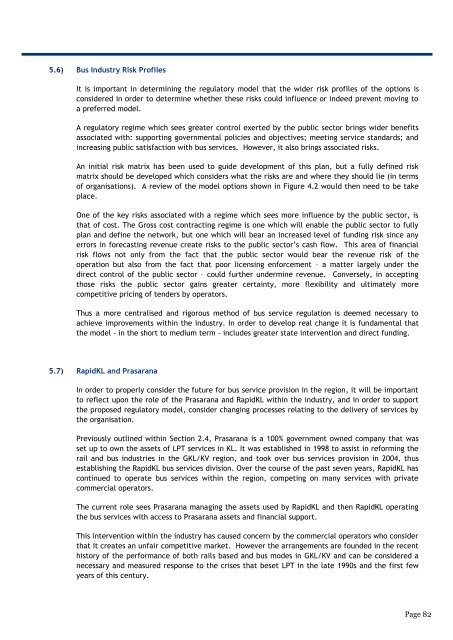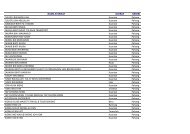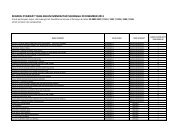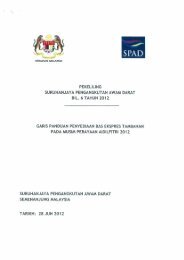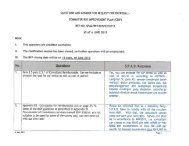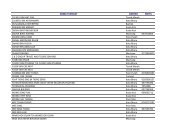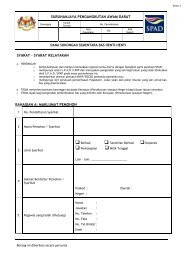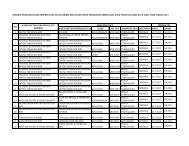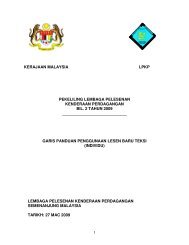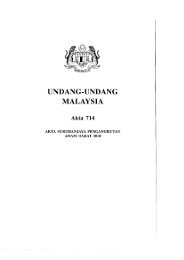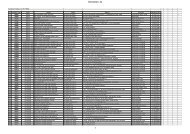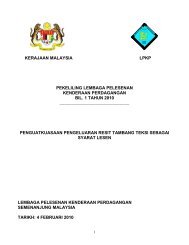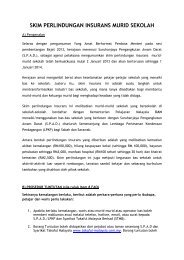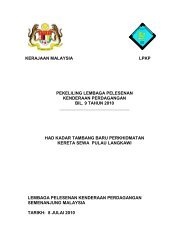Contents - SPAD
Contents - SPAD
Contents - SPAD
You also want an ePaper? Increase the reach of your titles
YUMPU automatically turns print PDFs into web optimized ePapers that Google loves.
5.6) Bus Industry Risk Profiles<br />
It is important in determining the regulatory model that the wider risk profiles of the options is<br />
considered in order to determine whether these risks could influence or indeed prevent moving to<br />
a preferred model.<br />
A regulatory regime which sees greater control exerted by the public sector brings wider benefits<br />
associated with: supporting governmental policies and objectives; meeting service standards; and<br />
increasing public satisfaction with bus services. However, it also brings associated risks.<br />
An initial risk matrix has been used to guide development of this plan, but a fully defined risk<br />
matrix should be developed which considers what the risks are and where they should lie (in terms<br />
of organisations). A review of the model options shown in Figure 4.2 would then need to be take<br />
place.<br />
One of the key risks associated with a regime which sees more influence by the public sector, is<br />
that of cost. The Gross cost contracting regime is one which will enable the public sector to fully<br />
plan and define the network, but one which will bear an increased level of funding risk since any<br />
errors in forecasting revenue create risks to the public sector‟s cash flow. This area of financial<br />
risk flows not only from the fact that the public sector would bear the revenue risk of the<br />
operation but also from the fact that poor licensing enforcement – a matter largely under the<br />
direct control of the public sector – could further undermine revenue. Conversely, in accepting<br />
those risks the public sector gains greater certainty, more flexibility and ultimately more<br />
competitive pricing of tenders by operators.<br />
Thus a more centralised and rigorous method of bus service regulation is deemed necessary to<br />
achieve improvements within the industry. In order to develop real change it is fundamental that<br />
the model - in the short to medium term - includes greater state intervention and direct funding.<br />
5.7) RapidKL and Prasarana<br />
In order to properly consider the future for bus service provision in the region, it will be important<br />
to reflect upon the role of the Prasarana and RapidKL within the industry, and in order to support<br />
the proposed regulatory model, consider changing processes relating to the delivery of services by<br />
the organisation.<br />
Previously outlined within Section 2.4, Prasarana is a 100% government owned company that was<br />
set up to own the assets of LPT services in KL. It was established in 1998 to assist in reforming the<br />
rail and bus industries in the GKL/KV region, and took over bus services provision in 2004, thus<br />
establishing the RapidKL bus services division. Over the course of the past seven years, RapidKL has<br />
continued to operate bus services within the region, competing on many services with private<br />
commercial operators.<br />
The current role sees Prasarana managing the assets used by RapidKL and then RapidKL operating<br />
the bus services with access to Prasarana assets and financial support.<br />
This intervention within the industry has caused concern by the commercial operators who consider<br />
that it creates an unfair competitive market. However the arrangements are founded in the recent<br />
history of the performance of both rails based and bus modes in GKL/KV and can be considered a<br />
necessary and measured response to the crises that beset LPT in the late 1990s and the first few<br />
years of this century.<br />
Page 82


